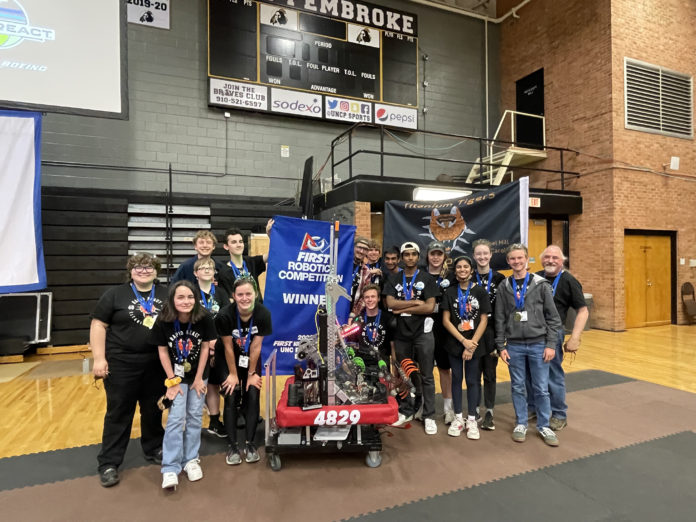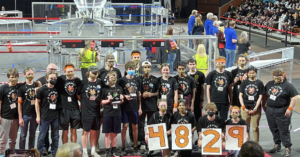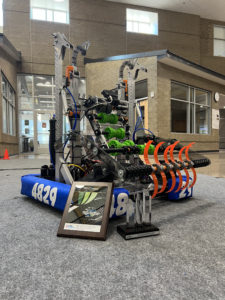
For four months, resting in Chapel Hill High School’s A building atrium, was a giant wood structure about 10 feet tall, greeting students making their way to their first-period classes in the morning.
“I was just passing [the tower],” freshman Dexter McQueen said. “I thought it was some sort of project, but had no idea what it was.”
The tower is actually similar to a hoop used by the school’s robotics team, the Titanium Tigers, to practice for this year’s For Inspiration and Recognition of Science and Technology (FIRST) robotics competition, a game called “Rapid React” in which teams compete to score as many baskets as they can in a two-minute-long period. The mechanical division of the team made the hoop completely from scratch—it is one of many accomplishments for the team that helped them test out their robot’s ability to shoot and score.
The Titanium Tigers may not get the same level of exposure as some of the school’s varsity sports teams, but this year’s Titanium Tigers had a historic season, making it all the way to the FIRST World Championships in Houston, the first time a Chapel Hill robotics team has done so. At events, teams representing their high schools are put into three-team “alliances” to compete against others, compelling students to work together with other students they may have never met before.
In 2022, the Titanium Tigers—Team 4829—held a record of 35-14-1, finishing with 285 total points, the third most in North Carolina.
The team participated in four official events, starting the season at a competition in Guilford County from March 25-27, where the team lost 9 of the 14 matches at the event. Although the team lost in the quarterfinals, the Titanium Tigers won the Achievement in Engineering award.
The next week, on April 3, the Titanium Tigers shifted their momentum at an event at UNC Pembroke, where they captained the top “alliance” and went on to win their first district banner, a large, blue banner awarded to the top finishing “alliance” at district events. The Tigers lost only one match at the event and won 17, a performance that bumped their ranking up to ninth in the state. The team’s faculty advisor, science teacher Stewart Riley, said it was the team’s closeness and camaraderie that allowed them to secure the win.
“This is a very tight team that works very well and closely together, constantly supporting each other,” Riley said. “[Senior] Nivas [Koli], our driver, can get a bit nervous and focused when matches are really on the line, but his teammates are always like, ‘Okay, man. You’re good—you’ve got this.’”

With the win at Pembroke, the Chapel Hill High School Robotics team qualified for the state championships, which was held April 8-10 at Campbell University. Although the team lost in the championship finals in two close matches, the Titanium Tigers competed strongly enough during the season to secure a spot in the world championship, finishing third in the state, the highest the team has ever placed.
“Going into the world championship, I was pretty calm but excited because we had already had our most successful season yet,” the team’s captain Koli said. “I was really just excited to go with the team to see some of the best teams compete in-person. But, to be honest, I was just humbled when we realized we qualified for worlds. I knew that we were capable of achieving more than we ever did before, but I didn’t think we would get as far as the world championship.”
Twenty-two team members traveled to Houston to compete in ten matches between April 20 and returned on the 23. The Tigers finished with a record of 3-6-1 and ranked 40 out of 76 teams in their division. In Qualifier 24, the team scored 19 goals to bring its alliance a narrow 143-136 win.
“The world championship competition was very stressful,” the Tigers’ head programmer and sophomore Ryan Atack said. “Something would break—a wire would be loose or something in the code would be wrong—and we’d have barely an hour to fix it.”
In addition to competing in the “Rapid React” basketball game, the robots must also climb up a row of ascending metal bars to score extra points once time has expired. “Rapid React” was meant to make competitors “reimagine the future of safe, high-speed travel and lightning-fast deliveries to propel the next evolution of transportation forward–in this world and beyond,” according to the FIRST website.
In the first part of each match, each robot had to function autonomously, without a person controlling it, using behavioral programming to move and shoot.
“Our visual targeting is done by a system called Limelight, which is a specific targeting camera,” Riley said. “Technically, it’s actually a Raspberry Pi computer with a camera and LEDs boxed up in a container that’s very good at processing visual information, specifically reflective targeting information.”

The robot, named Loopy, is controlled by sensor feedback loops in the autonomous part of each match and then by Koli.
“Constructing Loopy was no easy task; there were many debates about where we wanted to go with design and how we wanted to approach each mechanical aspect,” Koli said. “Through many arguments and meetings, we were about to create a list of what we wanted, needed and knew would be impossible to engineer.”
Atack had started working on Loopy in January, spending many hours at practices to perfect and improve upon the robot. Other students, he said, would stay at the school for hours, sometimes working until three a.m. tinkering with the robot.
“It took [the team] like three or four months just to get Loopy driving properly,” Atack said. “The robot uses swerve drive, so each wheel can rotate and move on its own, like those elementary school scooters. No matter which way the robot is pointing, if you rotate the stick to the left, it will go left, which makes it easy for the driver in competitions.”
After their loss at Guilford, the Tigers realized that the robot’s shooter was inadequate and spent three days in the following week, replacing it with an entirely new, improved version, which helped them captain the highest-ranked alliance at the Pembroke event, where they won the district banner.
“The shooter we designed put a lot of backspin on the balls we were shooting, and that backspin made them bounce back out of the goal very badly,” Riley said. “In a week’s time, the team came back, totally redesigned the shooter, built the new shooter, installed it on the robot and did some complex programming because it’s a two-wheel shooter whose trajectory is dependent on the RPM of each shooter wheel and the difference between them. And they had to integrate this with the targeting camera.”
The knowledge and experience that the Titanium Tigers gained, they say, is incredibly valuable and unforgettable.
Sophomore Avani Hoop—head of the Titanium Tigers’ business division—said she learned “how important outreach is” when seeing the importance of organizational grants, while Atack picked up Java, a programming language, in his time working on Loopy, both learning and utilizing a new language in the span of a school year.
Koli said that throughout his four years on the team he has learned “to operate a CNC machine, 3D print, weld, integrate designs, fabricate complex parts and lead a team of dedicated members,” all of which, he said, will help him in his studies at North Carolina State University, where he is majoring in engineering.
“I think that robotics has prepared me more than any other class for [my college education] because many of the design skills and fabrication skills are not taught in a typical class,” Koli said. “Learning to let go of good designs for better ones is something robotics has taught me and I am glad to have learned it.”











